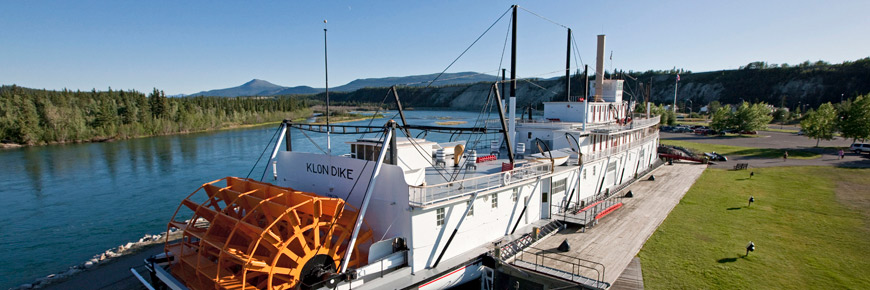
Designation information
S.S. Klondike National Historic Site
Printable version (PDF, 175 Kb)
Commemorating the inland water transportation system of the Yukon
Background
Steam powered river transportation was the central element in the development and connection of the Yukon to the outside world for almost a century after the first vessel reached Fort Selkirk in 1866. The character of the system that developed was shaped by the geography of the Yukon and the technology of the river boats. Alternative transport options developed slowly. It was only during and after World War II that road transport finally ended the importance of the inland water transport system in the Yukon.
Built in Whitehorse in 1929 by the British Yukon Navigation Company, a subsidiary of the White Pass and Yukon Route, the S.S. Klondike I represented a major breakthrough in sternwheeler design. The vessel was the first sternwheeler large enough to handle a cargo in excess of 272 tonnes (300 t. without having to push a barge.) The career of the S.S. Klondike I came to an abrupt end in 1936 when the vessel ran aground on a section of the Yukon River between Lake Laberge and the Teslin River.
The company immediately built the S.S. Klondike II. From 1937 to 1952 the Klondike was employed as a cargo vessel. Carrying general merchandise and a few passengers, the Klondike could make the downstream run from Whitehorse to Dawson (740.27km/460 mi) in 36 hours.
From Dawson the S.S. Klondike stopped at Stewart Landing where she loaded sacks of silver lead ore. Mined in the Mayo District, the ore was transported to Whitehorse then by rail to Skagway, Alaska.
Refurbished as a cruise ship in 1954, in an attempt to save her career, the S.S. Klondike II steamed into Whitehorse for the very last time in August of 1955.
Reasons for national historic importance
The largest vessel ever to ply the Canadian portion of the Yukon River, this sternwheeler was built by the British Yukon Navigation Co. and launched at Whitehorse in 1937 to replace her namesake, which sank the year before. S.S. Klondike II was designed to expedite the movement of silver-lead ore on the Yukon River. A combination freight and passenger boat, she operated primarily between Whitehorse and Dawson City. In 1954-55 the vessel was placed in cruise service after an extensive refurbishment. Her retirement in 1955 brought to an end the era of commercial steamboat navigation in the Yukon.
Milestones
1929
The S.S. Klondike, the largest sternwheeler in the British Yukon Navigational Company’s fleet, is launched.
1936
The S.S. Klondike sinks in the Thirty Mile section of the Yukon River. Construction of a new S.S. Klondike begins.
1937
The S.S. Klondike II is launched.
1954
The S.S. Klondike begins its second career as a passenger liner after extensive refurbishment of the vessel is completed.
1955
The last year the S.S. Klondike functions as a passenger liner. She is dry-docked in Whitehorse.
1959
S.S. Klondike is donated by the White Pass and Yukon Route Railway to the Government of Canada for $1.00.
1966
The S.S. Klondike is moved to its present location from the old Whitehorse Shipyards.
1967
The S.S. Klondike is designated a National Historic Site in 1967 and restoration work begins.
1981
The Site is officially opened.
1987
The HSMB reaffirms the national significance of S.S. Klondike. Further, the board recommends that the restored S.S. Klondike at Whitehorse should be given over to the interpretation of water transportation in the Yukon, exclusively.
Location
The S.S. Klondike is located on the banks of the Yukon River in downtown Whitehorse.
- Date modified :